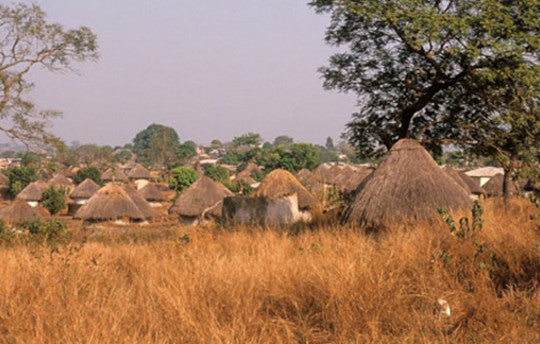Your Cart is Empty

Compared to neighboring Senegal and Mali, Guinea has a low profile on the World Music scene. Even so, it is one of the greatest places for music in West Africa.
The sound most commonly associated with Guinean music is that of the grand dance bands of the 1970s. Those and other styles are firmly rooted in the traditions of the Mande jelis (West Africa’s hereditary praise singers). Yet artists from other backgrounds have impacted the national scene.
The traditions of the Mande jelis have been the most important influence on Guinean popular music. The balafon is the instrument most characteristic of Guinean music and is the most popular jeli instrument in Guinea. Guitarists adapted the the percussive bounce of the balafon to create a typically Guinean style of finger-picking.
The djembe, associated with the Mande and Sussu, is deeply integrated in the traditions of many ethnic groups. In Guinea, the typical Mande patterns have been combined with other rhythms, resulting in a distinctive national style.
The Futa Jallon is an Islamic centre in the plateau region of western Guinea. Musicians of Fula Futa Jallon are called nyamakala and are frowned upon by Muslim society. Their inferior status granted these artists a license to indulge in despised behaviour. Elements of the nyamakala have found their way into the works of a number of Fula artists, including Petit Yero and Lama Sidibé.
The first urban orchestras appeared during the years of colonization. These bands played a mixture of European and Latin American popular music. The ensembles La Douce Parisette and La Joviale Symphonie dominated the music scene throughout the 1950s.
The guitar also made its appearance in Guinea during the early twentieth century and was the ultimate symbol of modernity. Sidiki Diabaté and Facelli Kanté were among the first to adapt the techniques of the balafon and ngoni to the guitar.
On October 2 1958, Guinea became the first French colony to gain independence and Sékou Touré became the first president. During the Touré years, Guinea had a flourishing music scene despite political oppression.
The 1960s and 70s were the time of the great dance orchestras. The development of a unique, modern Guinean music was an important part of Touré’s political agenda. Musicians were funded and thus afforded time to perfect their craft.
The first orchestra was the Syli National Orchestra whose first guitarist was the legendary “Grand” Papa Diabaté. They launched a new style, the Guinean rumba, a mix of traditional songs and Latin music. The group became unmanageably large, and split into Balla et ses Balladins and Kélétigui et ses Tambourins who enjoyed enormous popularity.
However, one group rose to fame above these—Bembeya Jazz. Their star attraction was Sékou “Diamond Fingers” Diabaté, the most gifted guitarist of his generation.
Also popular at the time were ballet troupes that celebrated the richness of the nation’s dance and drumming traditions. The most famous dance companies are the Ballet Djoliba and Les Ballets Africains.
By the early 1980s, Guineas’s dire economic situation had worsened. Large orchestras became difficult to maintain and financial support was reduced or discontinued. The new government promoted privatization and music became a profit-generating enterprise.
The more prestigious groups remained partially funded by the government, but attention had shifted to individual artists. This change in emphasis resulted in the emergence of a Western-style pop star culture.
Cassettes became available in the mid-1980s and were more affordable than vinyl. This allowed for music to be easily consumed to an unprecedented degree. The musical format evolved to feature a star singer with synthesizers, female chorus, and some live instrumentation. Sekouba Bambino Diabaté is one of the greatest singers of the contemporary Mande scene.
In the 1980s, unfavourable conditions drove many artists out of the country to Abidjan and Paris. 90% of all Guinean releases were recorded in Abidjan and Guinea lacks proper recording facilities to this day.
By the mid-1980s, the centre of the Mande pop world had shifted to Paris, where Guinea’s most famous artist Mory Kanté was based. The early 1990s Parisian dancefloor productions gave way to a quieter brand of Mande music. Jali Musa Diawara was one of first to use this retro-acoustic sound. This back-to-the-roots movement remained focused on the international World Music market and had little impact in Guinea.
Most established musicians are artists from prestigious jeli families, though this is gradually changing as musicians from other backgrounds enter the scene. Many are from a Fula background, adding nyamakala influences. These artists include Amadou Barry, and Lama Sidibé.
Two Sussu groups, Les Étoiles de Boulbinet and Les Espoirsde Coronthie have recently found chart-topper success. Maciré Sylla blends Mande music and Sussu vocals with jazz and Ba Cissoko combines a rootsy base with the inspired outlook of a young generation. Guinea also has a vibrant reggae and hip-hop scene. The best-known name in Guinean hip-hop is Bil de Sam.